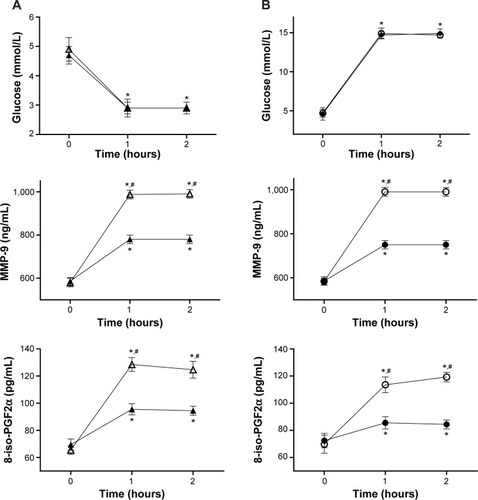Dear editor
MMP-9 has been involved in favoring cardiovascular disease, and evidence suggests that oxidative stress favors its release. Previous studies demonstrated that during both acute hyperglycemia and hypoglycemia an oxidative stress is produced in type 1 diabetes. On the other hand, GLP-1 has shown an antioxidant power. In this study an acute hyperglycemia and hypoglycemia, with or without the simultaneous infusion of GLP-1, were produced. During both hyperglycemia and hypoglycemia, an acute increase of MMP-9 and 8-iso-PGF2α plasma levels was observed. GLP-1 significantly reduced this increase. This study suggests that metalloproteinase-9 is activated by acute hyperglycemia and hypoglycemia because they generate an oxidative stress and that GLP-1 counteracts this effect.
Cardiovascular disease is a rising complication of type 1 diabetes.Citation1 MMP-9 has been involved in favoring cardiovascular disease,Citation2 and evidence suggests that MMP-9 is increased in the plasma of type 1 diabetic patients.Citation3,Citation4 Hyperglycemia seems to favor MMP-9 expression,Citation5,Citation6 possibly through the generation of an oxidative stress.Citation6
Attention is paid today to the possibility that GLP-1 and GLP-1 receptor agonists can be used in the management of type 1 diabetes.Citation7 We have recently shown that, in type 1 diabetes, GLP-1 protects endothelial function and reduces inflammation during both acute hyperglycemia and hypoglycemia.Citation8 GLP-1 exerts this protection increasing intracellular antioxidant defenses and decreasing the oxidative stress generated by both hyperglycemia and hypoglycemia.Citation8 Therefore, the aim of this study has been to evaluate the impact of both acute hyperglycemia and hypoglycemia on MMP-9 plasma levels and the possible protective effect of GLP-1.
Plasma samples regarding the experiments performed in type 1 diabetes were from the study previously published.Citation8 A total of 30 type 1 diabetic patients (15 males and 15 females) participated in such study.Citation8 For this new study, 30 healthy (17 males and 13 females), aged (24.0±2.3 versus [vs] 24.4±2.2 years, mean ± standard error) and body mass index (23.5±2.0 vs 23.7±2.2 kg/m2) matched controls were recruited. The assays for MMP-9 were performed at the same time.
The diabetic patients were divided into two groups.Citation8 In group 1, two different experiments were planned for each subject in a randomized order: a period of 2 hours of hypoglycemia (2.9±0. mmol/L), with or without GLP-1 (0.4 pmol kg−¹ min−¹) infusion.Citation8
Two different experiments were planned for each subject of group 2 in a randomized order: a period of 2 hours of hyperglycemic clamp (15 mmol/L), with or without GLP-1 (0.4 pmol kg−¹ min−¹) infusion.Citation8
At baseline and after 1 and 2 hours, glycemia, plasma 8-iso-PGF2α (Cayman Chemical, Ann Arbor, MI, USA) and MMP-9 (R&D Systems, Inc., Minneapolis, MN, USA.) plasma levels were measured. For the statistics and more details about the study see Ceriello et al.Citation8
Baseline 8-iso-PGF2α (67.5±4.8 vs 34.5±4.5 pg/mL, P<0.01), and MMP-9 (580.15±10.9 vs 290.10±12.4 ng/mL, P<0.01) were increased in diabetic patients compared to controls.
After 2 hours of hypoglycemia, 8-iso-PGF2α and MMP-9 significantly increased, compared to basal values (). When hypoglycemia was accompanied by the simultaneous infusion of GLP-1, all these phenomena were significantly attenuated (). Similar results were obtained in the hyperglycemic clamp experiments. After 2 hours of hyperglycemia, 8-iso-PGF2α and MMP-9 increased, compared to basal values (). When hyperglycemia was accompanied by the simultaneous infusion of GLP-1, all these phenomena were significantly attenuated ().
Figure 1 MMP-9 and plasma 8-iso PGF2α variations during acute hypoglycemia (A) and acute hyperglycemia (B), with or without GLP-1.

In this study, for the first time, we report that both acute hypoglycemia and hyperglycemia induce an increase of MMP-9 and that GLP-1 can counterbalance this effect. Our data suggest that MMP-9 is activated by acute hyperglycemia and hypoglycemia because they generate an oxidative stress. The data of 8-iso-PGF2α support this hypothesis. GLP-1 counteracts the effects of both hyperglycemia and hypoglycemia, probably because of its antioxidant activity.Citation8
Currently, there is huge interest in the use the GLP-1 receptor agonists for the therapy of type 1 diabetes.Citation7 Our data suggest an additional benefit of this use.
Disclosure
The authors do not have any conflicts of interest to disclose.
References
- SchnellOCappuccioFGenoveseSStandlEValensiPCerielloAType 1 diabetes and cardiovascular diseaseCardiovasc Diabetol20131215624165454
- BlankenbergSRupprechtHJPoirierOPlasma concentrations and genetic variation of matrix metalloproteinase 9 and prognosis of patients with cardiovascular diseaseCirculation2003107121579158512668489
- ShiauMYTsaiSTTsaiKJHaungMLHsuYTChangYHIncreased circulatory MMP-2 and MMP-9 levels and activities in patients with type 1 diabetes mellitusMt Sinai J Med20067371024102817195891
- JacqueminetSBen AbdesselamOChapmanMJElevated circulating levels of matrix metalloproteinase-9 in type 1 diabetic patients with and without retinopathyClin Chim Acta20063671–210310716426593
- SetiantoBYAchmadAFPurnomoLBSerum matrix metalloproteinase-9 levels in acute coronary syndrome patients with and without hyperglycemiaActa Med Indones2014462838925053679
- UemuraSMatsushitaHLiWDiabetes mellitus enhances vascular matrix metalloproteinase activity role of oxidative stressCirc Res200188121291129811420306
- TölleSGLP-1-analoga in der therapie des diabetes mellitus typ 1 [GLP-1 analogues in treatment of type 1 diabetes mellitus]Dtsch Med Wochenschr20141394221232126 German25289919
- CerielloANovialsAOrtegaEGlucagon-like peptide 1 reduces endothelial dysfunction, inflammation, and oxidative stress induced by both hyperglycemia and hypoglycemia in type 1 diabetesDiabetes Care20133682346235023564922
